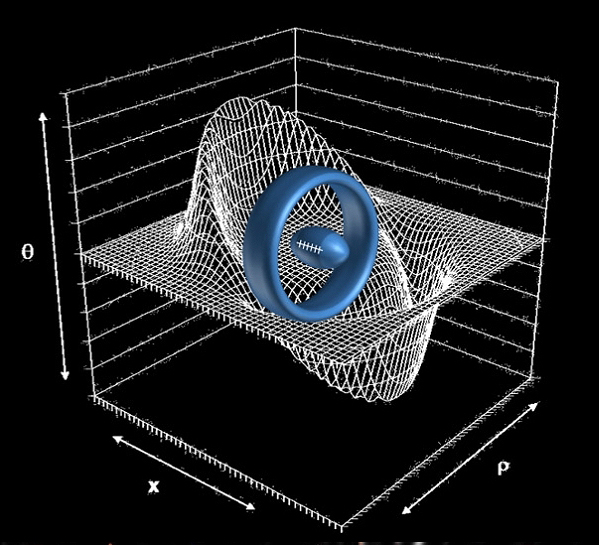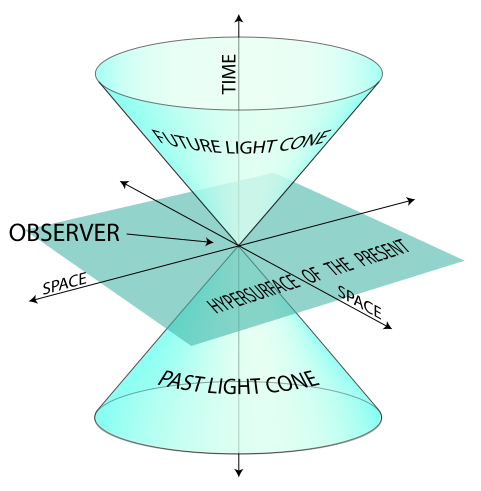The Concept of Hyperspace : Could it work?
The longest history of scientific discussions from all types of parallel universes boasts a parallel universe of higher dimensions. Common sense and sense organs tell us that we live in three dimensions (length, width and height). No matter how we move an object in space, its position can always be described by these three coordinates. In general, with these three numbers, a person can determine the exact position of any object in the universe, from the tip of his nose to the most distant galaxies.

hyperspace
At first glance, the fourth spatial dimension contradicts common sense. For example, when the smoke fills the entire room, we do not see it disappearing in another dimension. Nowhere in our universe do we see objects that would suddenly disappear or float away to another universe. This means that the higher dimensions, if any, are smaller in size than the atom.
Three spatial dimensions form the foundation, the basis of Greek geometry. For example, Aristotle wrote in his treatise On the Sky: "The magnitude divisible in one dimension is a line, in two - the plane, in three - the body, and, besides them, there is no other value, since the three [dimensions] are all [measurements] ". In the year 150 AD. e. Ptolemy of Alexandria proposed the first "proof" of the fact that higher dimensions are "impossible". In the treatise "On the Distance" he argues as follows. Draw three mutually perpendicular straight lines (like the lines that form the corner of the room). Obviously, it is impossible to draw a fourth line perpendicular to the first three, therefore, the fourth measurement is impossible. (In fact, he managed to prove this way only one thing: our brain is not able to visualize the fourth dimension.) On the other hand, computers are constantly engaged in calculations in hyperspace.)
For two millennia, any mathematician who dared to talk about the fourth dimension, risked being ridiculed. In 1685, mathematician John Wallis called it "a monster in nature, possible no more than a chimera or centaur" in a polemic about the fourth dimension. In the XIX century. "The King of Mathematicians" Karl Gauss developed the fourth-dimension mathematics to a large extent, but was afraid to publish the results, fearing a negative reaction. He himself, however, conducted experiments and tried to determine whether a purely three-dimensional Greek geometry truly describes the universe correctly. In one of the experiments, he placed three assistants on the tops of three neighboring hills. Each assistant had a lantern; the light of all three lamps formed a giant triangle in space. Gauss himself carefully measured all the angles of this triangle and, to his own disappointment, discovered that the sum of the internal angles of the triangle is actually 180 °. From this the scientist concluded that if deviations from the standard Greek geometry exist, they are so small that they can not be detected in such ways.
As a result, Georg Bernhard Riemann, a student of Gauss, was honored to describe and publish the foundations of mathematics of higher dimensions. (In a few decades, this mathematics was wholly included in Einstein's general theory of relativity.) In his famous lecture in 1854, Riemann in one fell swoop overturned the 2000 years of the reign of Greek geometry and established the foundations of mathematics of higher, curvilinear dimensions; we still use this mathematics today.
At the end of XIX century. the remarkable discovery of Riemann thundered throughout Europe and aroused the greatest interest of the public; the fourth dimension produced a real sensation among artists, musicians, writers, philosophers and artists. For example, art historian Linda Dalrymple Henderson believes that the cubism of Picasso appeared partly under the impression of the fourth dimension. (Portraits of the women of Picasso's brush, on which the eyes look forward and the nose is on the side, represent an attempt to present a four-dimensional perspective, because when viewed from the fourth dimension one can simultaneously see the face, nose and the back of the woman.) Henderson writes: "Like a black hole, The dimension possessed mysterious properties, which even the scientist could not fully understand. Yet the fourth dimension was much more understandable and representable than black holes or any other scientific hypothesis after 1919, with the exception of the theory of relativity. "

But historically, physicists considered the fourth dimension only as an amusing curiosity. There was no evidence of the existence of higher dimensions. The situation began to change in 1919, when the physicist Theodore Kaluza wrote a very controversial article, in which he hinted at the existence of higher dimensions. Starting with Einstein's general theory of relativity, he placed it in a five-dimensional space (four spatial dimensions and the fifth is time, since time has already established itself as the fourth dimension of space-time, physicists now refer to the fourth spatial dimension as the fifth). If you make the size of the universe along the fifth dimension less and less, the equations magically break up into two parts. One part describes Einstein's standard theory of relativity, but the other turns into Maxwell's theory of light!
This was a startling revelation. Perhaps the mystery of light is hidden in the fifth dimension! This decision shocked even Einstein; it seemed to provide an elegant combination of light and gravity. (Einstein was so shocked by Kaluza's assumption that he had been thinking twice for two years before agreeing to publish his article.) Einstein wrote to Kalutse: "The idea of obtaining a [unified theory] through a five-dimensional cylinder would never have occurred to me ... At first glance I really liked your idea ... The formal unity of your theory is amazing. "
For many years physicists have wondered: if light is a wave, then what, in fact, fluctuates? Light can overcome billions of light years of empty space, but empty space is a vacuum, there is no substance in it. So what is vacancy fluctuation? The theory of Kaluza made it possible to put forward a specific assumption in this regard: light is the real waves in the fifth dimension. Maxwell's equations, accurately describing all the properties of light, are obtained in it simply as equations of waves that move in the fifth dimension.

Imagine a fish swimming in a shallow pond. Perhaps they do not even know about the existence of the third dimension, because their eyes are looking to the sides, and they can swim only forward or backward, to the right or to the left. Perhaps the third dimension even seems impossible to them. But now imagine the rain on the surface of the pond. Fish can not see the third dimension, but they see shadows and ripples on the surface of the pond. Similarly, Kaluza's theory explains light as a ripple that moves along the fifth dimension.
Kaluza also gave an answer to the question of where the fifth dimension is located. Since we do not see around it any signs of its existence, it should be "rolled up" to such a small size that it is impossible to notice it. (Take a two-dimensional sheet of paper and roll it tightly into the cylinder. From a long distance, the cylinder will appear as a one-dimensional line, so you turned the two-dimensional object and made it one-dimensional.)
For several decades, Einstein began to work on this theory from time to time. But after his death in 1955, the theory was quickly forgotten, it turned into a funny note on the pages of the history of physics.
- REFERENCES :
Wikipedia: Faster than Light
http://en.wikipedia.org/wiki/Faster-than-lightNASA Status on Hyperspace:
http://www.nasa.gov/centers/glenn/technology/warp/warpstat_prt.htmThe-Hyperspace-Equation-Could-it-work
https://hubpages.com/education/The-Hyperspace-Equation-Could-it-work

SteemSTEM
SteemSTEM is a community-driven project that now runs on Steemit for more than a year. We seek to build a community of science lovers on Steemit and to promote well written/informative Science Technology Engineering and Mathematics (STEM) postings in order to make Steemit a place for fascinating STEM content.
More information can be found on the @steemstem blog and on the
Steemit chat.


wow
amaizing
This post has received a 0.53 % upvote from thanks to: @pario.
thanks to: @pario.
For more information, click here!!!!
Send minimum 0.100 SBD to bid for votes.
Before sending a transfer to @minnowhelper, verify that your publication meets these conditions (http://www.minnowhelper.com/conditions.php). After the transfer is made, no claims will be received.
The Minnowhelper team is still looking for investors (Minimum 10 SP), if you are interested in this, read the conditions of how to invest click here!!!
ROI Calculator for Investors click here!!!
I personally appreciate you and your post because you have added more hope into me about growth in steemit community, thanks.
How can you explain 2D people that a third 3Dimension exists?, for them this extra dimension is unthinkable, how can you explain to 3D people that there are extra dimensions? nice post; i explain this on my blog.